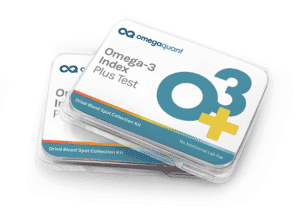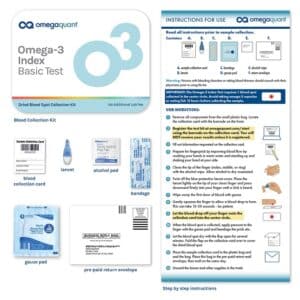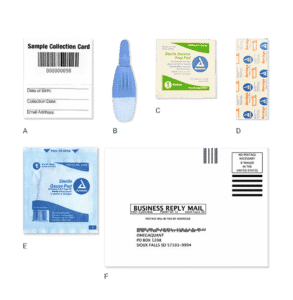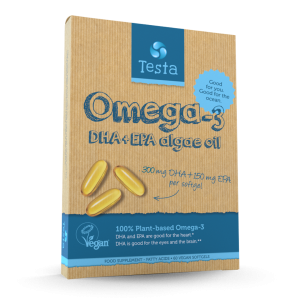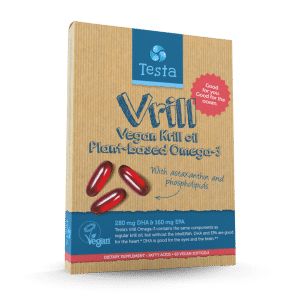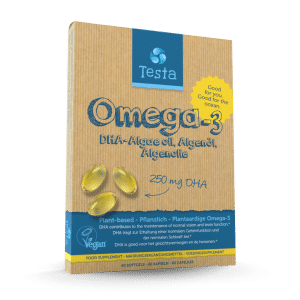Omega-3 Index Self-Test
-
Gain insights into your omega-3 index
-
Independent certified laboratory
-
Including advice to increase levels
Symptoms omega-3 deficiency

Brain Fog
If you’ve been unable to maintain your focus, omega-3 supplementation is something you may want to try! Get tested to find out if your levels are low.

Impaired Vision
Since DHA makes up 20% of the retina’s weight, having low levels of this fatty acid may affect its functions. Test your levels now!

Low Energy
Still sleepy even though you’ve been getting enough rest? You guessed it – your omega-3 levels can influence your energy as well. Find out if you need more healthy omega-3 fats today!
Are you getting enough omega-3s?
Studies show 9 out of 10 people do not get enough omega-3 fatty acids. The average American has an Omega-3 score of around 5%, but 8% is optimal for health.
Our omega-3 index test is a simple blood analysis that measures the fatty acid composition of your cell walls. The fatty acid composition, including EPA and DHA, reflects your eating pattern over the past three months. We are what we eat!
This simple omega-3 index test gives you a baseline to understand and achieve your essential fatty acid goals for better brain, heart, and eye health.
This kit includes comprehensive instructions explaining step-by-step blood collection, testing process, and online registration, a blood collection kit (blood collection card, lancet, disinfectant wipes, gauze, plaster), and a return envelope in which you can send your blood collection card free of charge for professional analysis to an independent and certified test laboratory.
Easy to follow steps:
First of all, collect your sample following the step-by-step blood collection instructions provided. Then, place the blood collection card in the return envelope, and send it to the addresses provided. Your sample will be analyzed by an independent test laboratory. After a few weeks, you’ll receive insight into your omega-3 index, and, if you’ve upgraded to Plus, your trans fat index, omega-3:6 ratio, AA:EPA ratio. You will also receive recommendations to achieve optimal omega-3 levels and balance your ratios as quickly and responsibly as possible.
Omega-3 Index
The Omega-3 Index Test measures the amount of DHA and EPA in your blood, specifically in the cell membranes of your red blood cells. Your cell walls consist of various fatty acids. The amount of omega-3 you consume through your diet is directly related to the concentration of DHA and EPA in your cell membranes and serves as a good indicator of your overall health. Try to aim for the recommended value of 8%.
Trans Fat Index
Trans fats are unsaturated fats that occur both naturally and are industrially produced. Naturally, they are found in animal products such as butter, milk, cheese, and meat—especially from cows and sheep. These natural trans fats are not comparable to the unhealthy industrial trans fats formed during the hydrogenation of vegetable oils, as found in frying fats and margarines. Fortunately, due to changes in production processes, this has become less common. If you see “hydrogenated fat” or “partially hydrogenated fat” on the ingredients list, you know you’re dealing with trans fats. It is recommended to keep the Trans Fat Index below 1%.
Omega-6 : Omega-3 Ratio
Many people view omega-6 (pro-inflammatory) as bad and omega-3 (anti-inflammatory) as good. That’s an oversimplification. The real issue is that the ratio of these fatty acids is out of balance due to the Western diet. Generally, a ratio between 3:1 and 5:1 is considered healthy, but some people have a ratio as high as 20:1. Can you imagine what that does to inflammation levels in your body?
AA:EPA Ratio
This is a less well-known but still interesting ratio. The test measures the amount of the omega-6 fatty acid arachidonic acid (AA) and the omega-3 fatty acid eicosapentaenoic acid (EPA). This ratio provides insight into the level of inflammation in your cells—the higher the AA:EPA ratio, the higher the level of inflammation. The ideal ratio lies between 2.5:1 and 11:1.
Scientific research* reveals that 9 out of 10 people do not get enough omega-3 fatty acids. The average Dutch person has an omega-3 index between 4 and 6%, while 8% or more is optimal for health. Do you know your omega-3 level?
The Omega-3 test is a simple blood analysis that measures the fatty acid composition of the walls of our body cells. The basic test measures the omega-3 content in your blood. You can later upgrade this to ‘Plus’, which also measures omega-6, providing insight into the omega-3 / omega-6 ratio.
The fatty acid composition, including EPA and DHA, reflects our eating habits over the past 3 months, so ‘you are what you eat’.
A single drop of blood or a drop of breast milk** is sufficient to measure various types of fatty acids. The most crucial aspect is calculating the percentage of omega-3 fatty acids EPA and DHA from the total measured fatty acids.
Plus test
When upgrading your basic test, you also measure the ratio between omega-6 and omega-3 fatty acids. For optimal functioning of various processes in your body, this ratio should be around 4:1. However, due to the significant increase in omega-6 in our diet, this ratio is often as high as 20:1 in many cases. Not optimal at all.
This kit includes comprehensive instructions explaining step-by-step blood collection, testing process, and online registration, a blood collection kit (blood collection card, lancet, disinfectant wipes, gauze, plaster), and a return envelope in which you can send your blood collection card free of charge for professional analysis to an independent and certified test laboratory.
The test takes about 5 to 10 minutes. Preferably perform the test in the morning while fasting (no food for 10 hours).
First, take all components out of the small plastic bag. Place the Sample Collection Card with the barcode visible on a table. Then register the test kit at omegaquant.com/start.
Select “create account.” Then choose “I am setting up a personal account.” Fill in all required information. Make sure to tick the final box agreeing to the terms and privacy policy. Check your inbox to confirm your account. Click the link to log in again. Select “Register Test Kits.” Type the barcode from the Sample Collection Card. Click “Register.” Answer the 2 questions and click “continue.” Click “continue” again. Registration is now complete.
Next, fill in your details on the Sample Collection Card. Prepare for the finger prick by washing your hands with warm water, stand up, and swing your arms at your sides. Clean your middle or ring finger with the provided Sterile Alcohol Prep Pad. Let the alcohol dry.
Twist off the cap of one of the provided lancets. Press the tip of the lancet firmly against your fingertip until you hear a “click.” Wipe away the first drop of blood using the Sterile Gauze Pad. Gently squeeze your finger to allow a drop of blood to form. This can take 15 to 30 seconds—be patient. Let the drop fall into the circle on the Sample Collection Card. Do not let your finger touch the card.
Once the circle is filled, use the Sterile Gauze Pad to stop the bleeding and place a bandage over the spot. Let the blood on the card dry for 5 minutes, then fold the protective flap over the blood spot. Place the Sample Collection Card in the plastic bag and seal it. Put the bag in the envelope and mail it the same day. No postage is needed. Discard all remaining items in the trash.
